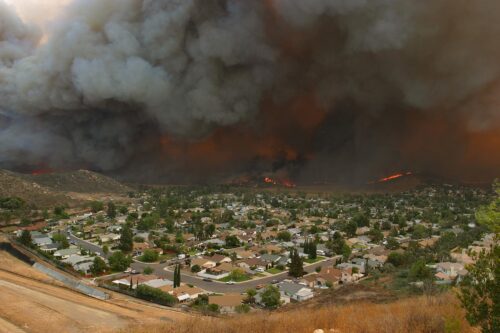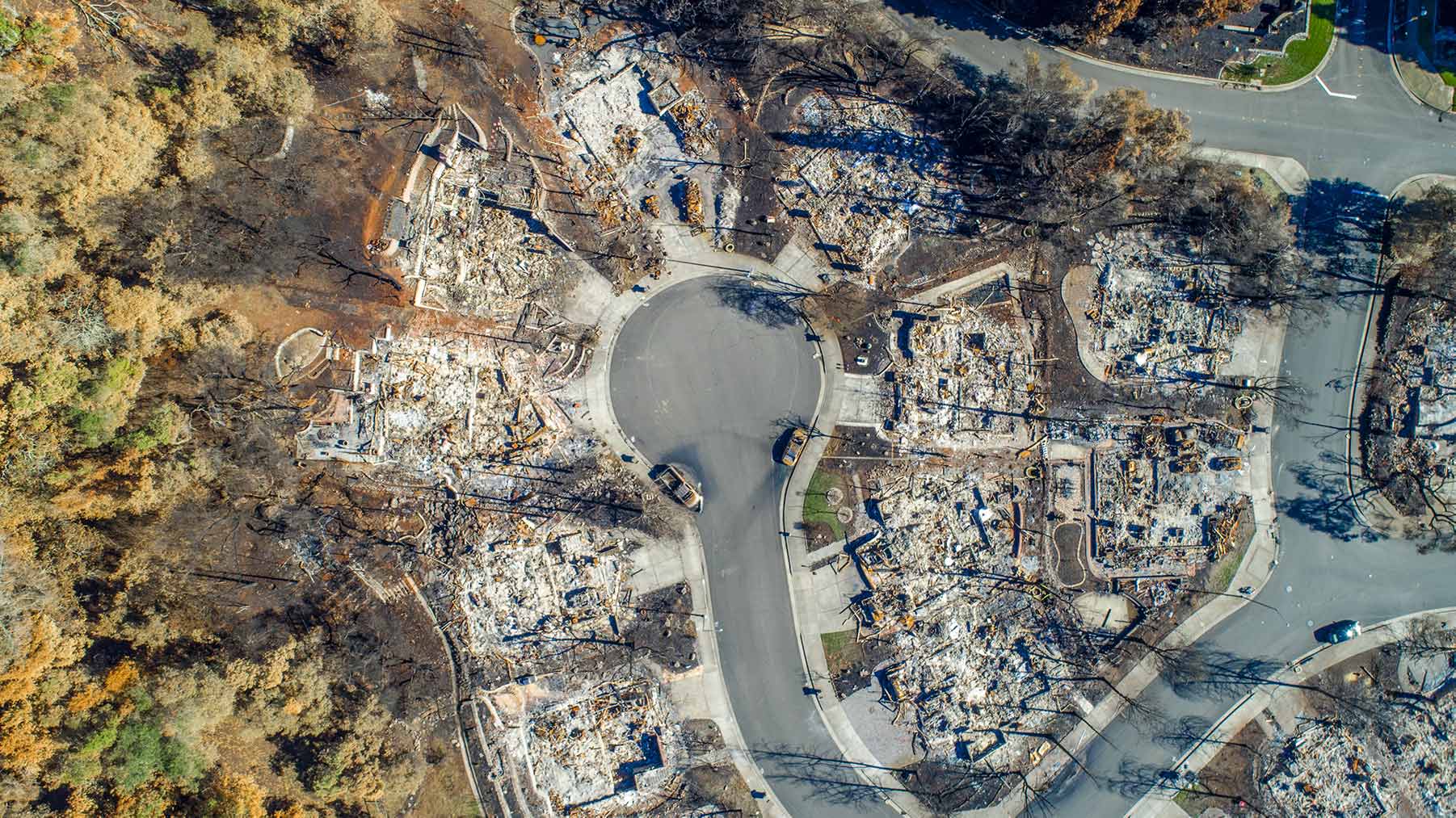
Rethinking the Status Quo of Property Insurance
As weather extremes intensify due to climate change, could innovative insurance approaches be an answer to more equitable disaster recovery?
This article is part of a series exploring challenges faced by households and communities in the wake of extreme weather events and the financing solutions that can advance resiliency.
Earth Day is just around the corner, and this year’s theme is all about investing in our planet. As we explore these opportunities, we’ll delve into how the property and casualty insurance (P&C) industry can be a leader in facilitating investments that future-proof and decarbonize home assets.
Climate change is dramatically impacting the P&C industry, which is responsible for backing the risk of property damage. The increased frequency and severity of climate-related extreme weather events, such as hurricanes and wildfires, has caused P&C losses to surpass $600 billion in the past decade. This has led insurers to cut coverage and increase premiums — essentially passing the risk on to homeowners. These consequences have resulted in — and will continue to result in — homebuyers purchasing homes that could later become unaffordable.

Withdrawal of insurance coverage after multiple major fires in northern and southern California in 2017 and 2018 is just one example of the consequences of this trend. Non-renewals by insurance companies increased by nearly 70,000 in 2019 and have remained elevated when compared with earlier years, leaving homeowners to choose between leveraging costly coverage under the state’s FAIR Plan or refraining from insurance coverage altogether.
The staggering statistics of the wildfires in California alone emphasize the importance of investing in proactive planning and solutions to prevent even greater financial losses throughout the housing and insurance industries, as well as across local communities and economies. With the number of billion-dollar climate events and subsequent catastrophic losses reaching an all-time high in the past decade, the time to act has never been greater. Innovative insurance products that facilitate collaboration between insurers, homeowners, and communities can create more resilient communities, more effectively mitigate risk, control cost, and help reduce the very emissions causing climate change in the first place.
Investing in foundational tools and streamlined data to manage risk
Government entities and third-party organizations have made significant progress in researching property-level climate risks, and it is promising that many insurers that previously underestimated climate-related risks are stepping up to use this data to increase focus on how those risks directly impact their portfolio. Today, 15 states require insurers to complete the National Association of Insurance Commissioners (NAIC) Insurer Climate Risk Disclosure Survey, a standardized, publicly available framework modeled from compliant reporting standards (from the Task Force on Climate-Related Financial Disclosures) to help insurance companies and regulators disclose and analyze portfolio-level climate-related financial information.
The survey is a foundational step in guaranteeing that insurers are evaluating climate-related risks their portfolios face. As more state insurance departments require the use of this (or a similar) survey, we can expect greater needs and standards for set methodologies that evaluate and disclose risks. Adequately assessing, modeling, pricing, and disclosing climate-related risks will support P&C insurers and their regulators with predicting and preparing for the growing financial and physical impacts of climate change.
Climate change is exacerbating insurance gaps for our most vulnerable communities, including farm workers and rural communities with the least savings to recover after a disaster. Insurance companies must be using all tools to manage their climate risk in a way that keeps insurance available and affordable, including scenario analysis, enhanced risk reports to regulators, and creative approaches to climate insurance for community-wide threats like flooding and wildfire.
Incentivizing mitigation and resilience measures
In addition to assessing and publicly disclosing potential climate-related risks, incentivizing mitigation of those risks is key. Insurers can play an active role in building risk awareness and facilitating investments in resilience strategies by developing a standardized method for incorporating resilience improvements into the valuation and insurance pricing models. In fall of 2022, California became the first state to require that insurers in the state reward homeowners who proactively invest in wildfire mitigation measures by offering lower premiums.
Resilience strategies ranging from minor home investments such as landscaping updates, to more complex home upgrades such as foundation elevation, provide long-term savings for homeowners and insurers alike, since insurance pricing is directly tied to the property’s risk. An analysis conducted by the National Institute of Building Sciences found that every dollar invested in protecting assets from natural disaster damage could result in up to $13 in savings.
Resiliency upgrades can also achieve improved home efficiency. For example, air sealing a home’s envelope, upgrading exterior features to be more durable, or installing new windows all aid in future-proofing a home to extreme weather while simultaneously lessening its carbon footprint. Additionally, because households are responsible for roughly 20 percent of total US carbon emissions, reducing a home’s carbon footprint will be the biggest single step to achieving long-term climate resilience.
A pathway to exploring new and innovative insurance models
Although taking steps to manage potential climate-related risks is crucial, the industry must also consider the longevity of current insurance models and pivot to innovative approaches when appropriate. Contrary to traditional P&C insurance coverage, parametric and community-level insurance models offer an alternative approach to promoting risk reduction while ensuring inclusive and equitable access to insurance protection.
Parametric insurance covers the probability of losses a policyholder’s property faces for a named disaster such as a hurricane, earthquake, or drought, and gives policyholders quicker access to more flexible funds to support resiliency upgrades or renovations. This framework benefits insurers as well since the payout is not tied directly to total property damage, but is paid out once a catastrophe meets a predetermined threshold (e.g., during a hurricane once wind speeds reach a certain point, a set dollar amount is paid to policyholders).
The Center for NYC Neighborhoods recently announced its plan to pilot among the first major parametric insurance programs in the United States to support low- and moderate-income households in maintaining financial resilience following extreme flood events. Outside of the United States, this framework has been more widely adopted and has proven successful. For example, in 2022, the United Nation’s World Food Programme utilized a parametric insurance framework to support roughly half a million West African people impacted by one of the most severe droughts the region has ever faced.
Furthermore, community-based catastrophe insurance, which is modeled from parametric insurance frameworks, offers another pathway to managing risks and ensuring that all individuals, including low-income households in high-risk areas, have financial protection and are not priced out of insurance policies. While community-based insurance has not been adopted in the United States to date, its framework of leveraging government support to arrange insurance for multiple properties within a community offers a compelling approach worthy of further exploration. Recent studies shed light on what the benefits could look like if coupled with nature-based mitigation strategies. For example, following the major midwestern US floods in 2019, a study conducted by The Nature Conservancy and Munich Re concluded that a levee-setback nature-based approach to reduce future flood impacts could be factored into insurance modeling and pricing. Their model found that a community-based insurance approach yielded lower insurance premiums per structure than traditional flood insurance coverage through the National Flood Insurance Program.
Approaching the future of climate insurance
These solutions represent only a few of the innovative strategies and tools that can address the impact of climate change on the P&C industry. From our analysis of key industry research, including a recent report produced by the California Department of Insurance’s Climate Insurance Working Group, greater investments by insurers will be necessary to meet growing needs as climate impacts worsen. These investments include minimizing catastrophic losses to home assets, modeling the impacts of climate events, and exploring innovative insurance frameworks outside of traditional P&C coverage. With climate-related events becoming more frequent and volatile, and the possibility to future-proof the insurance industry becoming more realistic, the time to act and invest in the future of our homes, communities, and planet is now.
If you are interested in learning more about industry solutions to address the growing catastrophic climate risks that continue to face the US housing stock, click here.